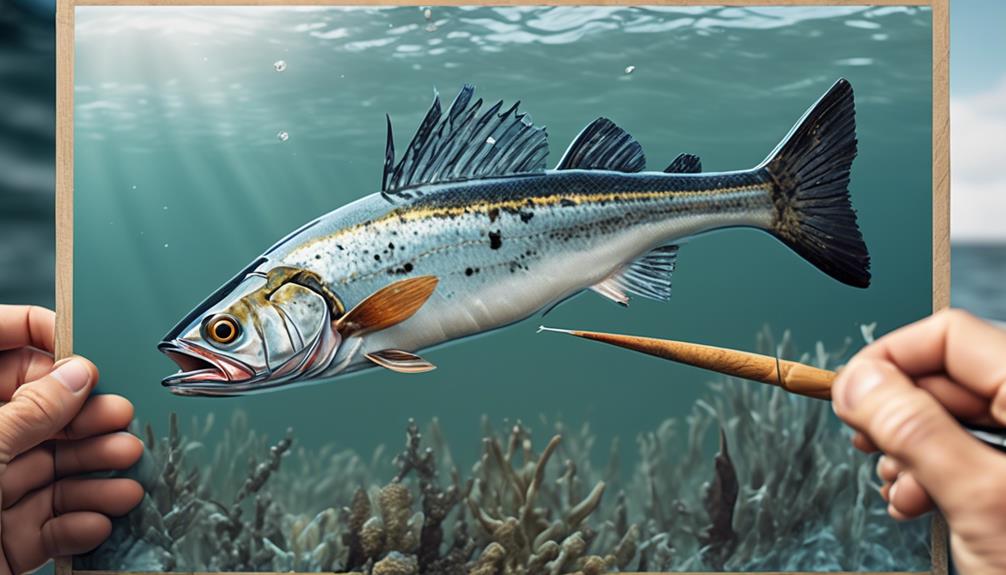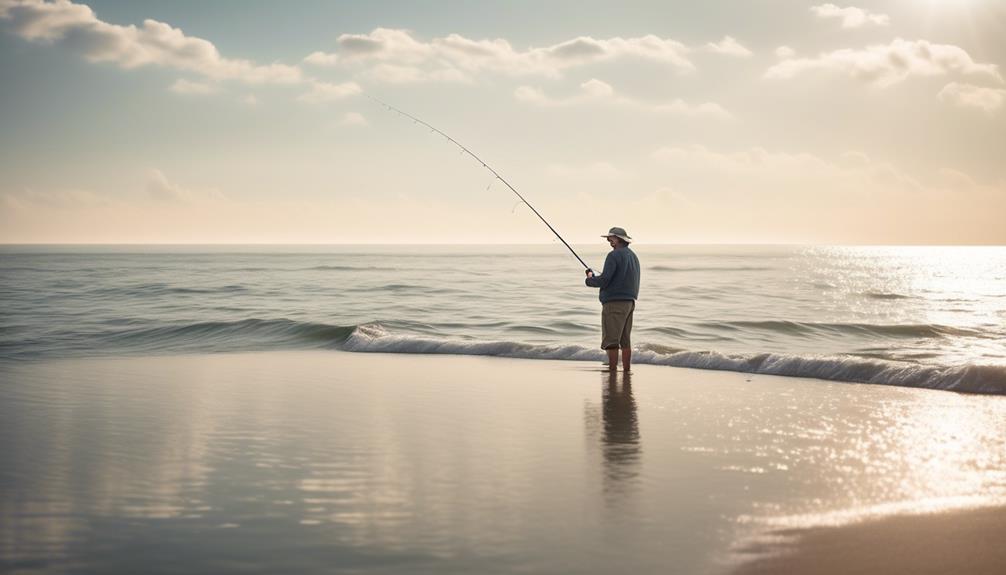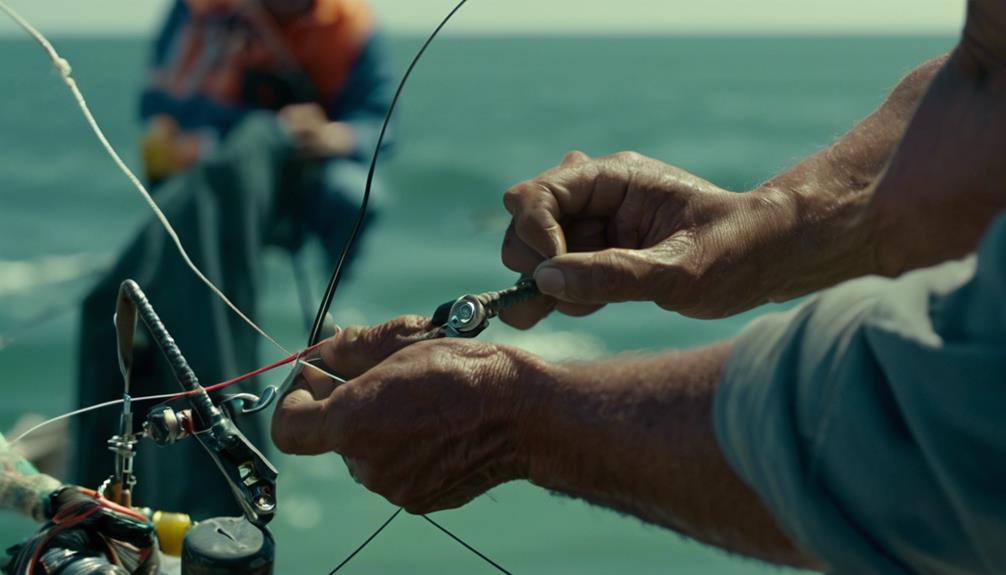When it comes to starting out in the world of fishing, you may find yourself torn between the tranquil freshwater lakes and the vast, unpredictable ocean. Both offer unique challenges and rewards, but there's something about saltwater fishing that draws you in, isn't there?
Perhaps it's the thrill of reeling in a powerful, shimmering catch, or the sense of adventure that comes with casting your line into the deep blue. Whatever it may be, there's a compelling reason to consider embarking on your fishing journey in the saltwater realm.
Benefits of Saltwater Fishing
If you're looking for a relaxing and fulfilling outdoor activity, saltwater fishing offers a range of physical and mental health benefits.
The first advantage is the diverse range of saltwater fishing locations available to you. Whether you prefer the open seas, coastal shorelines, or estuaries, there's a saltwater fishing spot that suits your preferences. This variety allows you to explore different environments and experience the beauty of the ocean while engaging in an enjoyable pastime.
Additionally, understanding and following fishing regulations is an essential part of the saltwater fishing experience. These regulations are designed to conserve marine life and ensure sustainable fishing practices. By adhering to these rules, you contribute to the preservation of ocean ecosystems and the continuation of the fishing tradition for future generations. Furthermore, being aware of fishing regulations enhances your knowledge of marine life and ecosystems, fostering a deeper appreciation for the environment.
Engaging in saltwater fishing not only provides physical benefits but also contributes to your mental well-being. The calming effect of the ocean, combined with the excitement of the catch, can reduce stress and anxiety. It offers an opportunity to disconnect from the demands of daily life and connect with nature, promoting mental clarity and relaxation.
Essential Gear for Beginners
When starting out in saltwater fishing, the essential gear for beginners includes a sturdy fishing rod and reel, appropriate fishing line, and a selection of various hooks and lures. A good rod and reel combo is essential for casting into the open waters and reeling in larger saltwater fish. Look for a medium to heavy-action rod that's around 7 to 9 feet long, paired with a durable saltwater spinning reel for versatility and ease of use. The fishing line should be strong enough to handle the fight of saltwater species, typically a monofilament or braided line with a test strength of at least 20 pounds.
Tackle Box Essentials:
- Hooks: Carry a variety of sizes and styles of hooks to accommodate different bait and fish species.
- Circle hooks are great for catch-and-release fishing as they often hook the fish in the corner of the mouth, reducing harm.
- J-hooks are versatile and commonly used for a wide range of saltwater species.
- Lures: Invest in a selection of saltwater lures such as topwater plugs, soft plastic swimbaits, and metal jigs to attract different types of fish. Varying the colors and sizes of your lures can increase your chances of enticing a bite, so having a diverse collection is beneficial.
Understanding Tides and Currents
Understanding tides and currents is crucial for saltwater anglers, as they directly impact the behavior and feeding patterns of the fish you're targeting. Tidal patterns play a significant role in determining the best times to fish in specific locations. As the tides fluctuate, they influence the movement and concentration of baitfish, which in turn attracts predatory fish. It's essential to study tide charts and understand how the water levels change to optimize your fishing success.
When fishing in areas with strong currents, such as inlets or channels, it's vital to comprehend and navigate these currents effectively. Fish often position themselves strategically to take advantage of the flow of water, using it to conserve energy while waiting for prey to be carried past them. As an angler, understanding these currents can help you identify potential hotspots where fish are likely to gather. Additionally, being able to navigate currents will improve your ability to present bait or lures naturally, increasing your chances of enticing a strike.
Furthermore, being aware of tidal movements and currents isn't only beneficial for finding fish but also for ensuring your safety. Strong currents can make boating or wading dangerous, so understanding how these elements change throughout the day is crucial for planning a safe and successful fishing trip. By mastering the art of understanding and utilizing tides and currents, you'll significantly enhance your saltwater fishing experience.
Selecting the Right Bait and Lures
To increase your chances of success, carefully selecting the right bait and lures is essential for saltwater fishing. When it comes to lure selection, consider the following factors to make an informed choice:
- Types of Lures:
- Topwater Lures: These lures float on the surface and create enticing movements that mimic prey, making them perfect for attracting aggressive fish like striped bass and redfish.
- Soft Plastic Lures: These lures are versatile and come in various shapes and sizes, making them ideal for imitating different types of baitfish and enticing a wide range of saltwater species.
Next, let's delve into the various bait options that can significantly impact your success:
- Bait Options:
- Live Bait: Using live bait such as shrimp, mullet, or squid can be highly effective as it presents a natural and enticing meal for predatory fish, increasing your chances of a successful catch.
- Cut Bait: Cut bait involves using sections of larger fish or squid to attract saltwater species. It releases scent and oils, attracting predatory fish and triggering their feeding response.
Fishing Techniques for Beginners
As you gain familiarity with selecting the right bait and lures, it's time to focus on fundamental fishing techniques for beginners.
Let's start with casting tips. When casting, hold the rod comfortably with your dominant hand and use your non-dominant hand to hold the line against the rod. Position your body so that your dominant side is facing the direction you want to cast. Then, bring the rod back over your shoulder and swiftly cast it forward, releasing the line at the right moment to propel the bait or lure into the water.
Practice your casting technique in an open area before hitting the water to avoid tangles and improve accuracy.
Next, let's talk about rod positioning. Keep your rod tip up while reeling in the line to maintain tension and feel the movements of your bait. When a fish bites, swiftly point the rod tip upwards to set the hook. This helps to prevent the line from going slack and increases the chances of a successful hookset.
Knot tying and line management are also crucial skills to master. Learn how to tie strong and reliable knots to secure your bait or lures to the line and to connect different parts of your fishing gear. Additionally, practice managing the line to prevent tangles and ensure smooth casting and reeling.
With these fundamental techniques, you'll be well on your way to enjoying a successful and enjoyable fishing experience.
Safety Tips for Saltwater Fishing
When fishing in saltwater, prioritize your safety by being aware of potential hazards and taking necessary precautions. The ocean presents unique challenges, and it's crucial to stay safe while enjoying your fishing experience. Here are some essential safety tips to keep in mind:
- Proper Hydration and Sun Protection
- Always carry an adequate supply of water to stay hydrated, especially when spending long hours under the sun. Dehydration can sneak up on you, so be proactive about drinking water.
- Apply and reapply sunscreen frequently, as the sun's rays can be intense out on the water. Wearing sunglasses and a wide-brimmed hat can also provide additional protection from the sun.
- Boat Safety and Emergency Procedures
- Familiarize yourself with the layout of the boat and locate essential safety equipment such as life jackets, flares, and a first aid kit. It's crucial to know where these items are in case of an emergency.
- Take the time to review and understand emergency procedures before setting out to sea. This includes knowing how to use communication devices, understanding distress signals, and being prepared for various emergency scenarios.
Identifying Common Saltwater Fish

When fishing in saltwater, you frequently encounter a variety of common fish species. Identifying these fish can be a rewarding part of the fishing experience. Here are some tips to help you recognize some of the most common saltwater fish species.
- Fish species:
- One of the most familiar saltwater fish is the redfish, also known as the red drum. It has a distinctive coppery-bronze color with a black spot at the base of its tail.
- Another common species is the snook, which has a sloping forehead and a black lateral line running from its gills to its tail.
- The snapper is recognizable by its sloping profile, prominent canine teeth, and a red or pink hue.
- Additionally, the tarpon is a well-known fish with a large, silvery body and a distinctive elongated lower jaw.
- Identification tips:
- When identifying saltwater fish, pay attention to the color, shape, and markings on the fish.
- Take note of any unique features, such as spots, stripes, or distinctive fins.
- Consider the size and behavior of the fish as well, as these can also be helpful in identification.
- Use a fish identification guide or app to assist you in recognizing different species.
Conservation and Ethical Practices
To ensure the sustainability of saltwater fishing, it's essential to adopt ethical practices and actively participate in conservation efforts. By following ethical practices and supporting marine conservation, you contribute to the preservation of fish populations and their habitats.
Here are some ways you can engage in ethical practices and contribute to marine conservation:
- Practice Catch and Release: When fishing, consider catching and releasing certain fish species to help maintain their populations. This practice ensures that the fish have the opportunity to reproduce and contribute to the overall health of the marine ecosystem.
- Use Barbless Hooks: Using barbless hooks can make it easier to release fish without causing unnecessary harm, promoting ethical and sustainable fishing practices.
- Support Marine Conservation Organizations: Get involved with or donate to marine conservation organizations that work to protect and restore marine environments. These organizations often engage in research, advocacy, and conservation initiatives aimed at preserving the oceans and their inhabitants.
Frequently Asked Questions
Can I Use Freshwater Fishing Gear for Saltwater Fishing?
Yes, you can use freshwater fishing gear for saltwater fishing, but it may not be ideal. Saltwater conditions can corrode freshwater gear. Consider investing in saltwater-specific tackle for better performance and gear longevity.
How Do I Handle Fish Properly to Ensure Their Survival After Catch and Release?
When handling fish properly, you ensure their survival after catch and release. Use conservation techniques like wet hands, barbless hooks, and quick releases. Protect the fish by minimizing air exposure and avoiding unnecessary harm.
What Are Some Common Mistakes That Beginners Make When Saltwater Fishing?
When saltwater fishing, common mistakes beginners make include using improper bait and not managing the tide effectively. To improve, choose suitable bait and learn to work with the tides for better success.
Are There Any Specific Regulations or Rules I Need to Be Aware of When Saltwater Fishing?
When saltwater fishing, regulations, licensing requirements, and conservation practices are crucial. Be aware of catch limits, fishing zones, and the environmental impact. Follow these rules to ensure a positive fishing experience and protect marine ecosystems.
What Are Some Common Challenges or Obstacles That Beginners May Face When Saltwater Fishing?
When saltwater fishing, beginners may face challenges like handling larger fish, understanding tides and currents, and navigating unfamiliar waters. Overcoming obstacles involves learning proper techniques, seeking advice, and practicing patience.
Conclusion
So, why start with saltwater fishing?
It's a thrilling and rewarding experience that offers a wide variety of fish to catch and stunning ocean views to enjoy.
With the right gear, knowledge of tides and currents, and understanding of fishing techniques, beginners can have a successful and enjoyable saltwater fishing experience.
Just remember to always prioritize safety, conservation, and ethical practices to ensure a sustainable and enjoyable fishing experience for future generations.
Happy fishing!



